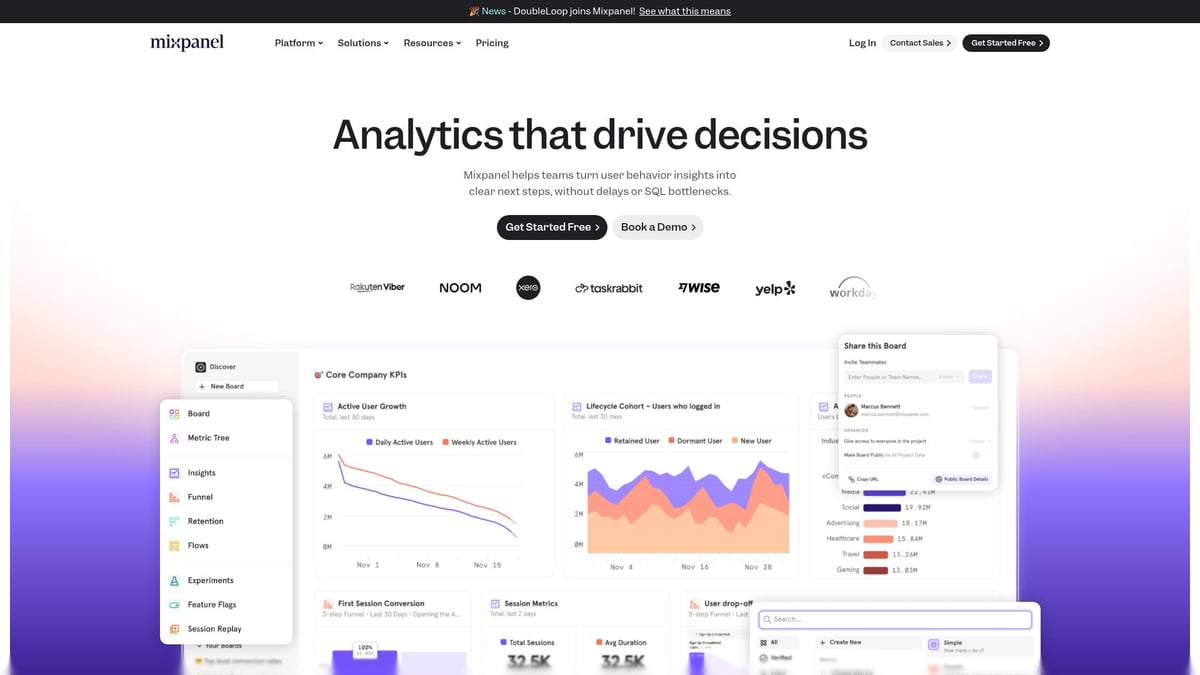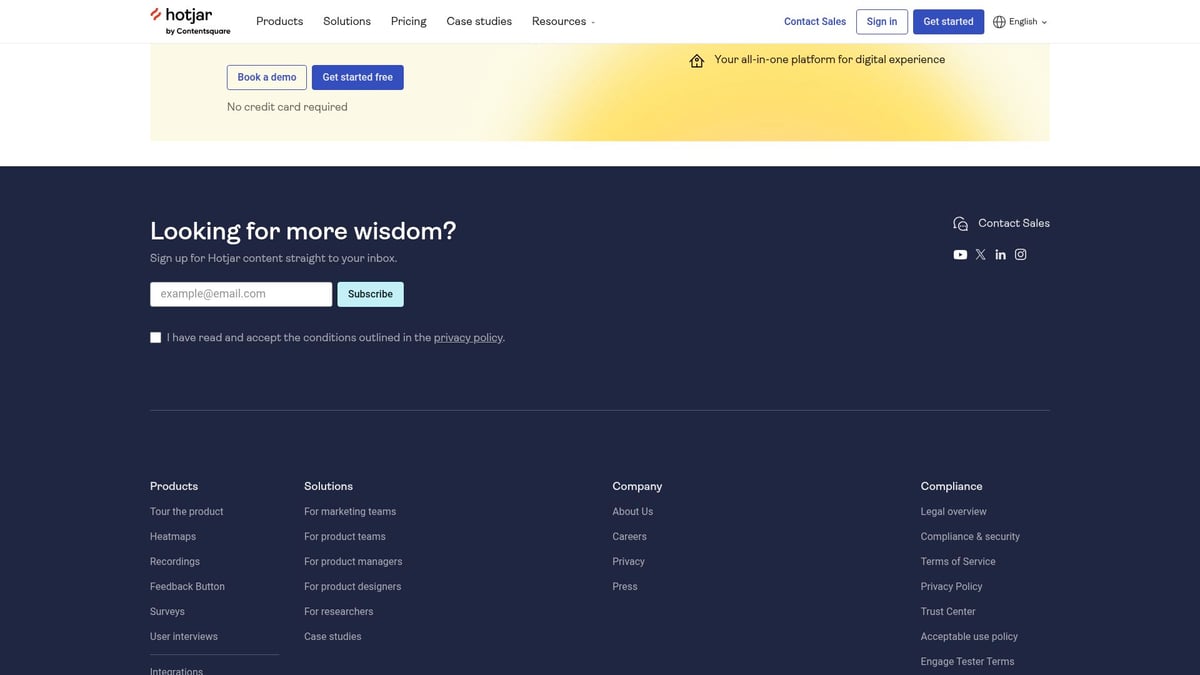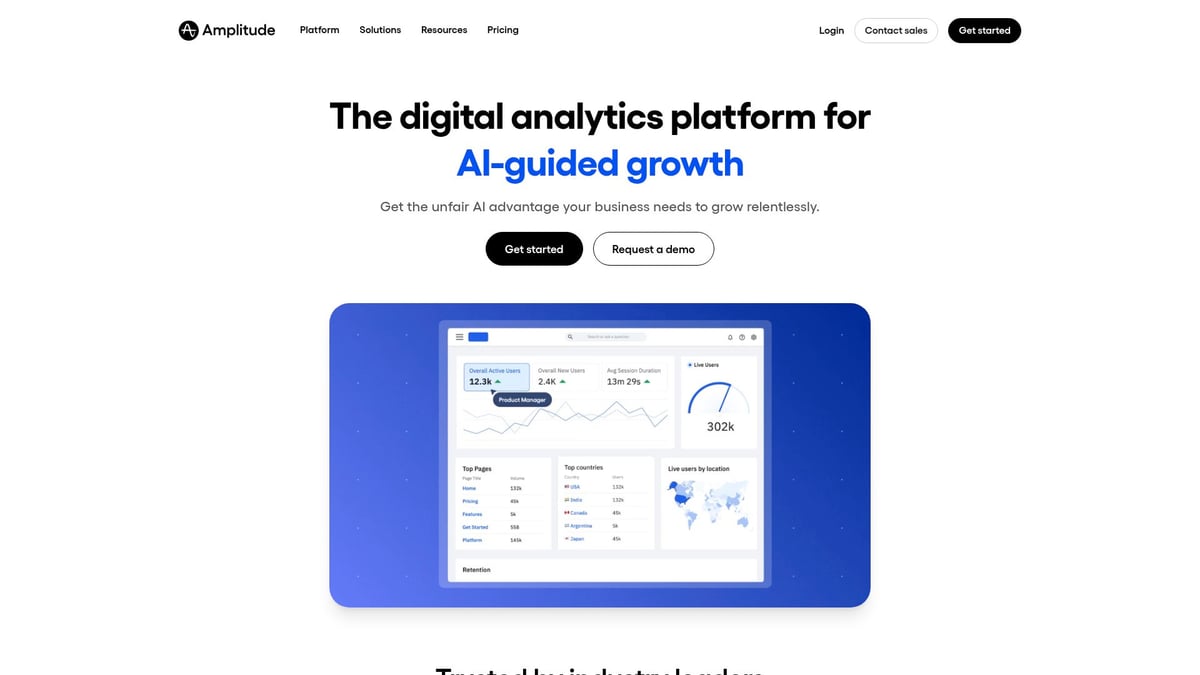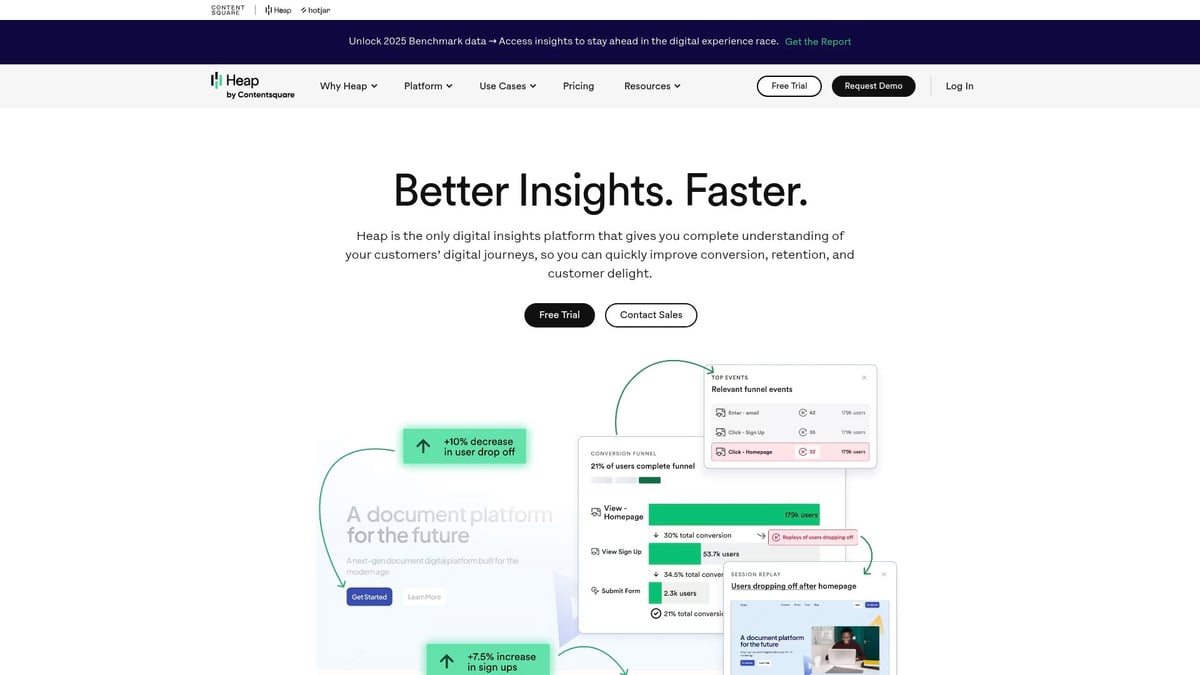- Date
7 Top Free Analytics Tool Picks for Smarter Insights in 2025
 Andrii Romasiun
Andrii Romasiun
In 2025, digital growth depends on turning vast data into clear, actionable insights. Yet, many businesses find it tough to access meaningful analytics without stretching their budgets.
The good news is that choosing the right free analytics tool can unlock smarter, data-driven decisions for any organization. This guide spotlights seven powerful options, each offering unique features, benefits, and pricing models.
Discover which free analytics tool fits your goals, so you can confidently drive results. Ready to make data work for you? Read on for the best picks.
Why Free Analytics Tools Matter in 2025
The Evolving Analytics Landscape
The digital world has never been more crowded or fast-paced. As new channels and platforms keep emerging, organizations need immediate, actionable insights to stay ahead. This surge in data sources makes a robust free analytics tool essential for making real-time decisions.
Privacy regulations, such as GDPR and CCPA, are also reshaping how analytics tools collect and manage data. Businesses now seek solutions that offer cookieless tracking and ethical data collection practices. As vendors compete to outdo each other, many now provide robust free analytics tool options, with features once exclusive to premium plans.
For example, companies leveraging a privacy-friendly free analytics tool can boost growth while respecting user rights. The landscape is shifting toward tools that empower rapid, compliant decision-making for all.
Key Benefits of Using Free Analytics Solutions
A modern free analytics tool offers more than just numbers—it provides real value for startups, nonprofits, and enterprises alike. The most immediate benefit is cost savings, allowing smaller organizations to compete on a level playing field.
Lower barriers to entry mean that marketing and product teams can access data-driven insights without lengthy procurement cycles. Many free analytics tool options now include advanced features like segmentation, real-time event tracking, and customizable reports, previously found only in paid solutions.
Organizations can test and scale these tools before committing to a paid tier. This democratization of data ensures that more team members can access, interpret, and act on insights, accelerating growth and fostering a culture of innovation.
What to Look For in a Free Analytics Tool
Choosing the right free analytics tool requires a careful evaluation of core features and compliance needs. At a minimum, look for real-time tracking, event monitoring, user segmentation, and comprehensive reporting capabilities.
Privacy compliance is non-negotiable. Ensure the tool respects data ownership and integrates seamlessly with your CMS, e-commerce, or marketing platforms. Customization and scalability are critical, so the solution can grow alongside your business.
Be aware of limitations in free plans, such as data caps or restricted features. A well-chosen free analytics tool should balance flexibility, privacy, and integration, enabling you to unlock actionable insights without hidden costs.
7 Top Free Analytics Tool Picks for Smarter Insights in 2025
Unlocking smarter insights is possible for every organization when you select the right free analytics tool. In 2025, a new wave of solutions empowers teams with robust features at no cost. Let’s explore seven standout platforms that help you turn data into action, achieve privacy compliance, and scale your digital strategy without overspending.
Swetrix – Privacy-First, Open-Source Analytics
Swetrix is a leading free analytics tool for privacy-conscious organizations. The Community Edition is free to self-host, while the cloud version offers a 14-day free trial before moving to paid tiers.

Core features include cookie-less tracking, real-time and historical analytics, error monitoring, customizable alerts, and a fully open-source codebase. Swetrix stands out for its 100 percent data ownership, GDPR compliance, and the fact that you do not need cookie banners. Its dashboard is intuitive, and you can set up custom events and funnels with ease.
This free analytics tool is ideal for startups, SMBs, developers, and especially EU-based companies needing privacy by design. Swetrix allows teams to collaborate and integrate via API, making it a flexible choice.
Pros:
- Ethical, privacy-first analytics
- Self-hosting for full data control
- No cookies or banners required
- Customizable events and funnels
- Team collaboration features
Cons:
- No perpetual free cloud plan
- Technical setup required for self-hosting
For example, privacy-focused businesses in Europe rely on Swetrix to meet compliance requirements while still gaining actionable insights. If you want a free analytics tool that prioritizes privacy and flexibility, Swetrix is a top contender.
Mixpanel – Interactive Product & User Analytics
Mixpanel is a popular free analytics tool that brings interactive event-based tracking to product and growth teams. Its free plan covers up to 100,000 monthly tracked users, with paid options starting at $20 per month.

Mixpanel specializes in event tracking, retroactive funnels, cohort analysis, A/B testing, and robust visualization. Its segmentation capabilities are powerful, enabling users to dissect customer journeys and identify key conversion points instantly.
This free analytics tool is particularly attractive for SaaS companies, product managers, and app developers seeking deep user behavior insights. The platform integrates easily with data lakes and supports flexible reporting.
Pros:
- Deep event and funnel analysis
- Generous free tier
- Real-time analytics and reporting
- Direct integrations for data lakes
Cons:
- Some advanced features require payment
- Has a learning curve for new users
Growth teams utilize Mixpanel to pinpoint conversion bottlenecks and improve retention strategies. If you need a free analytics tool that excels at product analytics and segmentation, Mixpanel is a strong choice.
Hotjar – Heatmaps & User Behavior Visualization
Hotjar is a free analytics tool designed for visualizing user behavior through heatmaps, session recordings, and feedback tools. The free plan is suitable for new websites and small projects, while paid plans start at $39 per month for advanced features.

Hotjar’s core features include heatmaps to visualize clicks and scrolls, session recordings to watch real user journeys, and on-site feedback polls and surveys. It blends qualitative and quantitative data, providing a holistic view of user experience.
This free analytics tool is a favorite among UX/UI designers, marketers, and e-commerce teams who want to see exactly how visitors interact with their sites. The interface is intuitive and setup is simple.
Pros:
- Visual insights into user behavior
- Easy to install and use
- Direct feedback from real users
Cons:
- Limited data retention on free plan
- Not ideal for complex event tracking
E-commerce stores use Hotjar to optimize landing pages and identify friction points. If you want a free analytics tool that translates user actions into clear visual data, Hotjar is a smart pick.
Google Analytics – Universal Website Analytics Standard
Google Analytics remains the most widely adopted free analytics tool for websites of all sizes. Its standard version is free for most users, while GA 360 caters to enterprise needs at a premium.
Key features include real-time traffic monitoring, audience demographics, conversion tracking, e-commerce reporting, and seamless integration with the Google ecosystem like AdWords and Data Studio. Its customizable dashboards and robust reporting set the industry standard.
Google Analytics is ideal for agencies, marketers, bloggers, and enterprises seeking comprehensive data at no cost. However, privacy concerns and the learning curve of GA4 are notable drawbacks. Sampling can occur on large datasets.
Pros:
- Extensive data and reporting
- Free for most use cases
- Integrates with Google tools
Cons:
- Privacy compliance challenges
- GA4 can be complex to master
Agencies often use Google Analytics to track multi-channel campaigns and optimize content. If you are comparing options, you might find this Alternatives to Google Analytics post helpful for evaluating other free analytics tool solutions that respect privacy and offer different features.
Amplitude – Customer Journey & Retention Analytics
Amplitude is a free analytics tool tailored for deep product and retention analytics. Its free plan supports up to 10 million actions per month, with paid plans starting at $49 monthly.

Amplitude’s core features include behavioral analytics, growth engine, cohort analysis, retention tracking, and custom dashboards. Unique benefits include benchmarking feature releases, advanced SQL access, and collaborative analytics.
This free analytics tool is best for product managers, SaaS businesses, and growth teams who need to map customer journeys and measure feature adoption.
Pros:
- Powerful journey and retention mapping
- Generous free usage limits
- Collaborative analytics environment
Cons:
- Complex interface for beginners
- Advanced features gated behind paid tiers
SaaS startups leverage Amplitude to analyze onboarding flows and boost activation rates. For teams needing in-depth product analytics, Amplitude is a reliable free analytics tool.
Open Web Analytics – Open-Source & Self-Hosted
Open Web Analytics is a completely free analytics tool that is self-hosted and open-source. It gives you full data control, making it a favorite among privacy-focused organizations and technical teams.
OWA tracks pageviews, events, heatmaps, goal conversions, and offers click-stream analysis. It integrates with WordPress out of the box and can be customized with plugins and extensions.
This free analytics tool is suitable for developers, nonprofits, and anyone wanting to avoid vendor lock-in. There are no data caps or hidden costs, but you must handle hosting and maintenance yourself.
Pros:
- Free forever, open-source
- Full data ownership and privacy
- Highly customizable
Cons:
- Requires technical setup and upkeep
- Fewer integrations than commercial tools
Nonprofits and tech teams often turn to OWA to avoid sharing data with third parties. If you want a free analytics tool with total control and transparency, OWA is a leading choice.
Heap – Automatic Event Tracking & Hidden Insights
Heap is a free analytics tool built around automatic event tracking and powerful retroactive analysis. It offers a free plan with custom pricing for advanced features.

Heap captures every user action automatically, letting you map funnels, analyze conversions, and uncover hidden behaviors without manual tagging. Its interface is user-friendly, and onboarding is quick.
This free analytics tool is popular with product teams, growth marketers, and agencies who need fast setup and deep insights. However, some advanced features are only available in paid plans, and privacy policies must be reviewed carefully.
Pros:
- Auto-capture of all events
- Fast, easy onboarding
- Retroactive analysis and funnel mapping
Cons:
- Feature limits on free plan
- Some privacy considerations
Product teams use Heap to quickly spot friction in onboarding flows and iterate rapidly. If you want a free analytics tool that minimizes setup and reveals actionable insights fast, Heap deserves your attention.
Comparing the Top Free Analytics Tools: Features, Limitations & Best Use Cases
In a crowded analytics marketplace, choosing the right free analytics tool can make or break your digital strategy. With so many options, a clear, side-by-side comparison helps you identify which solution aligns with your business goals and technical needs.
Feature-by-Feature Comparison
A direct feature comparison is essential when evaluating each free analytics tool. The core differences often lie in real-time tracking, event monitoring, heatmaps, privacy standards, and integration options.
Below is a summary table highlighting how the leading tools stack up:
| Tool | Real-Time Analytics | Event Tracking | Heatmaps | Privacy Focus | Integrations | Data Retention (Free) |
|---|---|---|---|---|---|---|
| Swetrix | Yes | Yes | No | Strong (GDPR) | API, CMS | Unlimited (self-host) |
| Mixpanel | Yes | Yes | No | Moderate | Data lake, APIs | 60 days |
| Hotjar | Yes | Limited | Yes | Moderate | CMS, e-commerce | 30 days |
| Google Analytics | Yes | Yes | No | Weak | Google suite | 14 months (default) |
| Amplitude | Yes | Yes | No | Moderate | APIs, data export | 12 months |
| OWA | Yes | Yes | Yes | Strong | WordPress, plugins | Unlimited |
| Heap | Yes | Auto | No | Moderate | APIs, CMS | 12 months |
Some tools, like Swetrix and OWA, prioritize privacy and data ownership, making them ideal for compliance-heavy industries. Others, such as Mixpanel and Amplitude, excel at user journey mapping and granular cohort analysis.
Heatmaps and user behavior visualization are Hotjar’s strengths, while Heap’s automatic event tracking sets it apart for rapid onboarding. Integrations range from robust (Google Analytics, Mixpanel) to highly customizable (OWA, Swetrix).
For a deeper dive into how these solutions compare across pricing, features, and ideal use cases, you can explore the Best Web Analytics Tools 2025: Complete Comparison Guide.
Choosing the Right Tool for Your Needs
Selecting the optimal free analytics tool starts with aligning your organization’s size, industry, and privacy requirements with each platform’s strengths. Startups and SMBs may benefit from Swetrix’s privacy-first approach or OWA’s open-source flexibility, while SaaS teams often gravitate toward Mixpanel or Amplitude for advanced product analytics.
E-commerce businesses aiming for visual insights should consider Hotjar for its intuitive heatmaps and feedback tools. Agencies and marketers who manage multiple sites might prefer the familiarity and integration depth of Google Analytics.
If your focus is event tracking or mapping detailed user journeys, tools like Heap and Mixpanel offer exceptional depth. For guidance on setting up effective event tracking, refer to this event tracking guide for websites.
When scaling, evaluate whether open-source or self-hosted solutions provide more control and cost efficiency, or if cloud-based platforms offer the support and scalability you require. Combining tools is also common: pairing a free analytics tool focused on quantitative data with a visual tool like Hotjar can deliver a fuller picture.
Ultimately, the right fit depends on your data goals, technical resources, and compliance needs. Test multiple platforms, review integration capabilities, and ensure your team can easily access and act on the insights provided.
How to Get Started: Best Practices for Implementing Free Analytics Tools
Unlocking the full potential of a free analytics tool starts long before you install any tracking code. Laying the right groundwork ensures your data delivers actionable insights, not just noise. Begin by clarifying your goals—what do you want to know, and why does it matter for your business? Define the key performance indicators (KPIs) that will measure success. Map out your customer journeys so you know which touchpoints require tracking.
Step-by-Step Setup for Success
To ensure your free analytics tool is deployed effectively, follow this streamlined process:
| Step | Action | Why It Matters |
|---|---|---|
| 1 | Define business goals | Focuses your analytics efforts |
| 2 | Select relevant KPIs | Measures what truly matters |
| 3 | Map user journeys | Identifies key touchpoints |
| 4 | Choose the right free analytics tool | Matches tool to your needs |
| 5 | Set up tracking and integrations | Ensures comprehensive data |
Before going live, test your setup. Simulate user interactions to verify that all events, conversions, and paths are tracked accurately. Integrate your free analytics tool with your website, app, and any marketing platforms you use. Remember to review privacy requirements, especially if you handle user data from regions like the EU or California.
Ensuring Privacy Compliance and Seamless Integration
Privacy and compliance are non-negotiable. Choose a free analytics tool that supports privacy features such as cookieless tracking and GDPR settings. Update your privacy policy to reflect data collection practices. If cookies are used, implement consent banners as needed.
Integration is now easier than ever, thanks to plugins and APIs. Most tools offer guides for connecting with popular CMS or e-commerce platforms. Leverage these to reduce manual setup and minimize errors. Regularly audit your tracking for accuracy and compliance.
Training Teams and Avoiding Common Pitfalls
Adoption is key to maximizing your free analytics tool. Train your team on both the technical and strategic aspects of the platform. Encourage a culture where data-driven decisions are routine, not the exception.
Avoid these pitfalls:
- Tracking too many events, which can dilute focus.
- Ignoring qualitative insights from heatmaps or surveys.
- Collecting data but failing to act on it.
- Overlooking the importance of data governance.
Empower more team members by setting up role-based dashboards and automated reports. This democratizes access and ensures insights are shared across departments.
Learning from Real-World Wins and Next Steps
Many businesses achieve rapid growth by leveraging a free analytics tool for quick wins. For example, startups often identify onboarding friction points within days of implementation, while e-commerce sites optimize landing pages using heatmap data.
Ongoing education is crucial. Tap into official documentation, webinars, and user forums for your chosen platform. For a deeper dive into the best free analytics solutions and practical advice on setup, check out this Top 10 site analytics tools guide, which offers actionable comparisons and tips.
By following these best practices, you can confidently implement a free analytics tool that delivers real, measurable value—no matter your organization’s size or stage.
After exploring the top free analytics tools for 2025, it's clear that finding the right fit is all about balancing robust insights with privacy and simplicity. If you're looking for a solution that prioritizes user privacy without sacrificing depth or flexibility, Swetrix stands out with its intuitive, cookie-less tracking and GDPR-compliant features. You’ll appreciate how easy it is to understand your visitors and optimize your website while maintaining full data ownership. Ready to see how smarter analytics can drive your growth in the coming year?
Try Swetrix today and experience the difference for yourself.